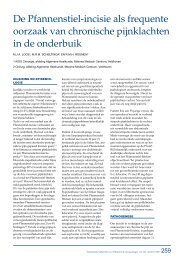Surgical management of chronic inguinal pain syndromes - Liespijn
Surgical management of chronic inguinal pain syndromes - Liespijn
Surgical management of chronic inguinal pain syndromes - Liespijn
Create successful ePaper yourself
Turn your PDF publications into a flip-book with our unique Google optimized e-Paper software.
INTRODUCTIONChronic <strong>pain</strong> following elective <strong>inguinal</strong> hernia repair is common. Approximately 14 to54 per cent <strong>of</strong> patients still experience some degree <strong>of</strong> <strong>inguinal</strong> <strong>pain</strong> several years after‘successful’ surgery 1-6 . Moreover, up to 21 per cent <strong>of</strong> patients is functionally impaired inwork or leisure activities 1,2 . One per cent <strong>of</strong> individuals suffering from <strong>pain</strong> after openrepair is eventually referred to a specialized <strong>pain</strong> clinic, as is 0.4 per cent after laparoscopichernia repair 7 .Efforts have been made to clarify the etiology <strong>of</strong> these postoperative <strong>pain</strong> <strong>syndromes</strong>using <strong>pain</strong> descriptors in questionnaires 2,3 . Neuropathic symptomatology was more<strong>of</strong>ten present compared to non-neuropathic descriptors suggesting a significant nerverelatedcontribution to <strong>pain</strong>. However, this approach only allows for a limited insight inunderlying etiology. A complete physical examination possibly supported by additionaltesting may provide answers in the quest for a correct diagnosis and tailored treatmentregimens.Aims <strong>of</strong> the present study were to classify postherniorrhaphy <strong>pain</strong> <strong>syndromes</strong> followingelective <strong>inguinal</strong> hernia repair.DEFINITIONSSome authors have attempted to classify <strong>inguinal</strong> <strong>pain</strong> after hernia repair 8,12 . In thepresent study it was decided to make a distinction between neuropathic and non-neuropathic(nociceptive) causes <strong>of</strong> <strong>pain</strong> as suggested by Amid 12 .Neuropathic <strong>pain</strong> is characterized as an activity-induced sharp <strong>pain</strong>, located in proximityto the <strong>inguinal</strong> scar. The <strong>pain</strong> frequently radiates towards scrotum, labium and/orupper inner thigh. Upper body stretching or twisting and/or hip joint flexing may cause<strong>pain</strong> due to nerve traction or compression. Physical examination <strong>of</strong>ten reveals signs <strong>of</strong>a disturbed neurophysiologic equilibrium including hypoesthesia, hyperesthesia orallodynia. A distinct trigger point situated in or close to the scar may cause <strong>pain</strong>following stimulation, e.g. after palpation. A local anaesthetic nerve block can possiblyact as a diagnostic and (temporary) therapeutic agent. The complex <strong>of</strong> symptomatologyis thought to be caused by an entrapment <strong>of</strong> ilio<strong>inguinal</strong>, iliohypogastric or genitalbranches <strong>of</strong> the genit<strong>of</strong>emoral nerves. Suture material, staples or tacks, perineuralfibrosis or prosthetic material are all implicated as well as accidental iatrogenic nervedamage possibly causing a neuroma.In non-neuropathic causes <strong>of</strong> <strong>inguinal</strong> <strong>pain</strong> after hernia repair, other conditions areresponsible for symptomatology including residual/ recurrent hernias, hip pathology,periostitis pubis, etc. All nerves are usually intact. These definitions are applicable in thefollowing text.PATIENTS AND METHODSThe study was conducted in the Máxima Medical Center, a teaching hospital servingapproximately 350,000 inhabitants in the Eindhoven and Veldhoven region, TheNetherlands. Patients were eligible for study if they reported moderate or severe <strong>pain</strong>(Visual Analogue Scale, VAS ≥ 3, range 0 = no <strong>pain</strong>, 10 = unbearable <strong>pain</strong>) as identifiedby a recent questionnaire study (figure 1) 1 .Eligible patients were contacted and invited at the <strong>Surgical</strong> Outpatient Department fora standardised interview and physical examination. Current <strong>pain</strong> intensity was thenagain tested using a VAS-score. Patients received a local injection <strong>of</strong> 10 cc lidocainhydrochlorid1% (Lidocain®) if the combination <strong>of</strong> patient’s history and physical examination(trigger point) suggested <strong>pain</strong> <strong>of</strong> neuropathic origin. If a non-neuropathic origin<strong>of</strong> <strong>pain</strong> was suspected, the diagnostic approach depended on the suggested diagnosis.For instance, if a periostitis was diagnosed, patients received a local injection containing5 cc lidocain and 40 mg methylprednisolonacetaat 40 mg/ml (depo-medrol® = corticosteroid)at the site <strong>of</strong> maximal <strong>pain</strong> intensity. Additional imaging techniques includingultrasound, CT-scans, or Magnetic Resonance Imaging were performed if deemednecessary. Following a 10 minute equilibrium period after injection, this regimen’sefficacy was evaluated using a VAS score.RESULTSDemographic and <strong>pain</strong> characteristicsFigure 1 describes patient inclusion. A total <strong>of</strong> 211 patients (11.9 per cent) was eligible forstudy as dictated by a VAS-score ≥ 3. Sixty-three patients did not visit the outpatientdepartment for reasons stated in figure 1, leaving 148 patients (8.4 per cent) for analysis.The mean age <strong>of</strong> participants was forty years, with the majority being male (87.2 percent, table 1). Most hernia operations were done by open techniques (76.4 per cent,mainly Lichtenstein) whereas almost one quarter <strong>of</strong> patients (23.6 per cent) was treatedusing a laparoscopic method (TEP 12.8 per cent, TAPP 10.8 per cent).Pain history <strong>of</strong> the study population is listed in Table 2. Almost 90 per cent reportedgroin <strong>pain</strong> prior to corrective surgery. However, the present postoperative <strong>pain</strong> level wasjudged comparable or worse by half <strong>of</strong> the patients. Nearly always the <strong>pain</strong> had starteddirectly after surgery, and its severity was considered by 28 patients (18.9 per cent) to beprogressive. More than half <strong>of</strong> the individuals was constantly suffering from <strong>pain</strong>. Other<strong>chronic</strong> <strong>pain</strong> <strong>syndromes</strong> (<strong>chronic</strong> headache, low back <strong>pain</strong> etc) were observed in 31.8 percent <strong>of</strong> patients.66 Chapter 5Classifying postherniorrhaphy <strong>pain</strong> <strong>syndromes</strong> following elective groin hernia repair 67





